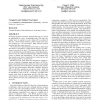Free Online Productivity Tools
i2Speak
i2Symbol
i2OCR
iTex2Img
iWeb2Print
iWeb2Shot
i2Type
iPdf2Split
iPdf2Merge
i2Bopomofo
i2Arabic
i2Style
i2Image
i2PDF
iLatex2Rtf
Sci2ools
WWW
2006
ACM
2006
ACM
Cat and mouse: content delivery tradeoffs in web access
Web pages include extraneous material that may be viewed as undesirable by a user. Increasingly many Web sites also require users to register to access either all or portions of the site. Such tension between content owners and users has resulted in a "cat and mouse" game between content provided and how users access it. We carried out a measurement-based study to understand the nature of extraneous content and its impact on performance as perceived by users. We characterize how this content is distributed and the effectiveness of blocking mechanisms to stop it as well as countermeasures taken by content owners to negate such mechanisms. We also examine sites that require some form of registration to control access and the attempts made to circumvent it. Results from our study show that extraneous content exists on a majority of popular pages and that a 25-30% reduction in downloaded objects and bytes with corresponding latency reduction can be attained by blocking such cont...
| Added | 22 Nov 2009 |
| Updated | 22 Nov 2009 |
| Type | Conference |
| Year | 2006 |
| Where | WWW |
| Authors | Balachander Krishnamurthy, Craig E. Wills |
Comments (0)

